The Intel Optane Memory (SSD) Preview: 32GB of Kaby Lake Caching
by Billy Tallis on April 24, 2017 12:00 PM EST- Posted in
- SSDs
- Storage
- Intel
- PCIe SSD
- SSD Caching
- M.2
- NVMe
- 3D XPoint
- Optane
- Optane Memory
Sequential Read
Sequential access is usually tested with 128kB transfers, which is large enough that requests can typically be striped across multiple controller channels and still involve writing a full page or more to the flash on each channel. Real-world sequential transfer sizes vary widely depending on factors like which application is moving the data or how fragmented the filesystem is.
The drives were preconditioned with two full writes using 4kB random writes, so the data on each drive is entirely fragmented. This may limit how much prefetching of user data the drives can perform on the sequential read tests, but they can likely benefit from better locality of access to their internal mapping tables. These tests were conducted on the Optane Memory as a standalone SSD, not in any caching configuration.
Queue Depth 1
The test of sequential read performance at different transfer sizes was conducted at queue depth 1. Each transfer size was used for four minutes, and the throughput was averaged over the final three minutes of each test segment.
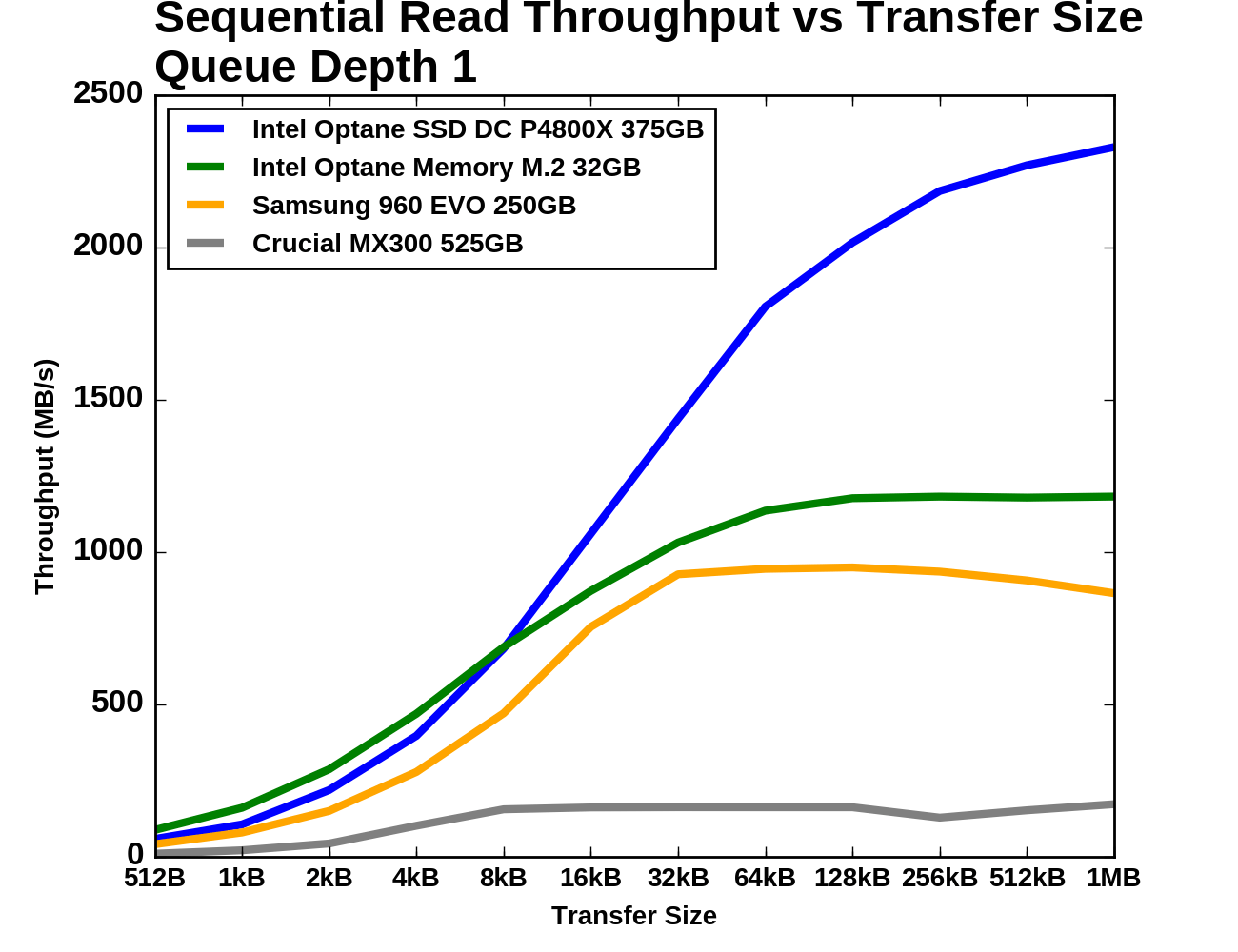 |
|||||||||
| Vertical Axis scale: | Linear | Logarithmic | |||||||
The three PCIe drives show similar growth through the small to mid transfer sizes, but the Optane Memory once again has the highest performance for small transfers and higher performance across the board than the Samsung 960 EVO.
Queue Depth > 1
For testing sequential read speeds at different queue depths, we use the same overall test structure as for random reads: total queue depths of up to 64 are tested using a maximum of four threads. Each thread is reading sequentially but from a different region of the drive, so the read commands the drive receives are not entirely sorted by logical block address.
The Samsung 960 EVO and Optane Memory start out with QD1 sequential read performance and latency that is relatively close, but then at higher queue depths the Optane Memory jumps up to a significantly higher throughput.
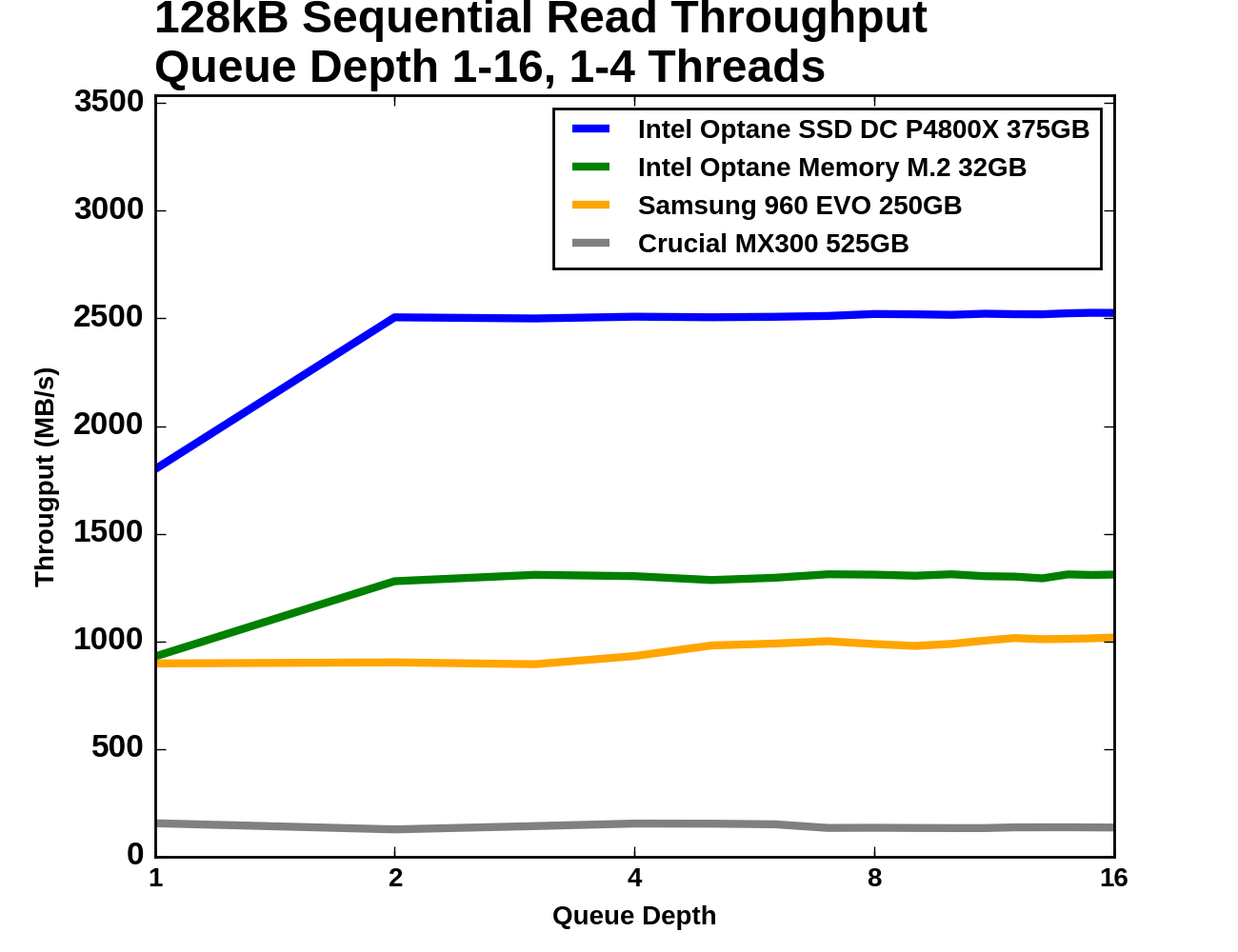 |
|||||||||
| Vertical Axis scale: | Linear | Logarithmic | |||||||
The two Optane devices saturate for sequential reads at QD2, but the Optane Memory experiences a much smaller jump from its QD1 throughput. The flash SSDs are mostly saturated from the start. The Crucial MX300 delivers far lower performance than SATA allows for, due to this test being multithreaded with up to four workers reading from different parts of the drive.
 |
|||||||||
| Mean | Median | 99th Percentile | 99.999th Percentile | ||||||
Since all four drives are saturated through almost all of this test, the latency graphs are fairly boring: increasing queue depth increases latency. For mean and median latency the Optane Memory and the Samsung 960 EVO are relatively close, but for the 99th and 99.999th percentile metrics the 960 EVO is mostly slower than the Optane Memory by about the same factor of two that the P4800X beats the Optane Memory by.
Sequential Write
The sequential write tests are structured identically to the sequential read tests save for the direction the data is flowing. The sequential write performance of different transfer sizes is conducted with a single thread operating at queue depth 1. For testing a range of queue depths, a 128kB transfer size is used and up to four worker threads are used, each writing sequentially but to different portions of the drive. Each sub-test (transfer size or queue depth) is run for four minutes and the performance statistics ignore the first minute. These tests were conducted on the Optane Memory as a standalone SSD, not in any caching configuration.
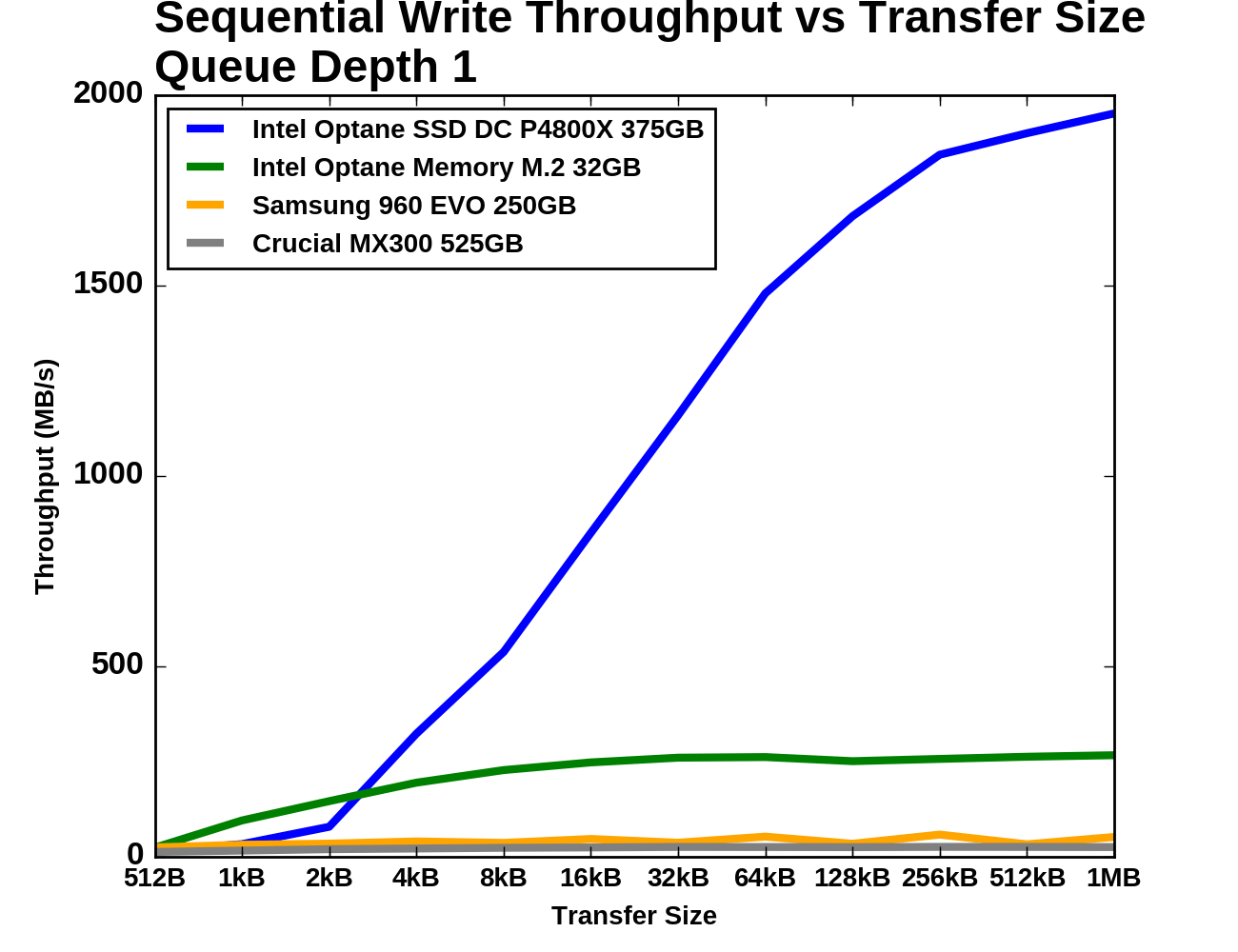 |
|||||||||
| Vertical Axis scale: | Linear | Logarithmic | |||||||
The enterprise-focused Optane SSD P4800X is slower than the consumer Optane Memory for sequential writes of less than 4kB, and even the Samsung 960 EVO beats the P4800X at 512B transfers. The 960 EVO's performance is inconsistent through the second half of the test but on average it is far closer to the MX300 than either Optane device. For larger transfers the MX300 is about a tenth the speed of the Optane Memory.
Queue Depth > 1
The sequential write throughput of the Optane SSD DC P4800X dwarfs that of the other three drives, even the Optane Memory. The Optane Memory does provide substantially higher throughput than the flash SSDs, but it does not have a latency advantage for sequential writes.
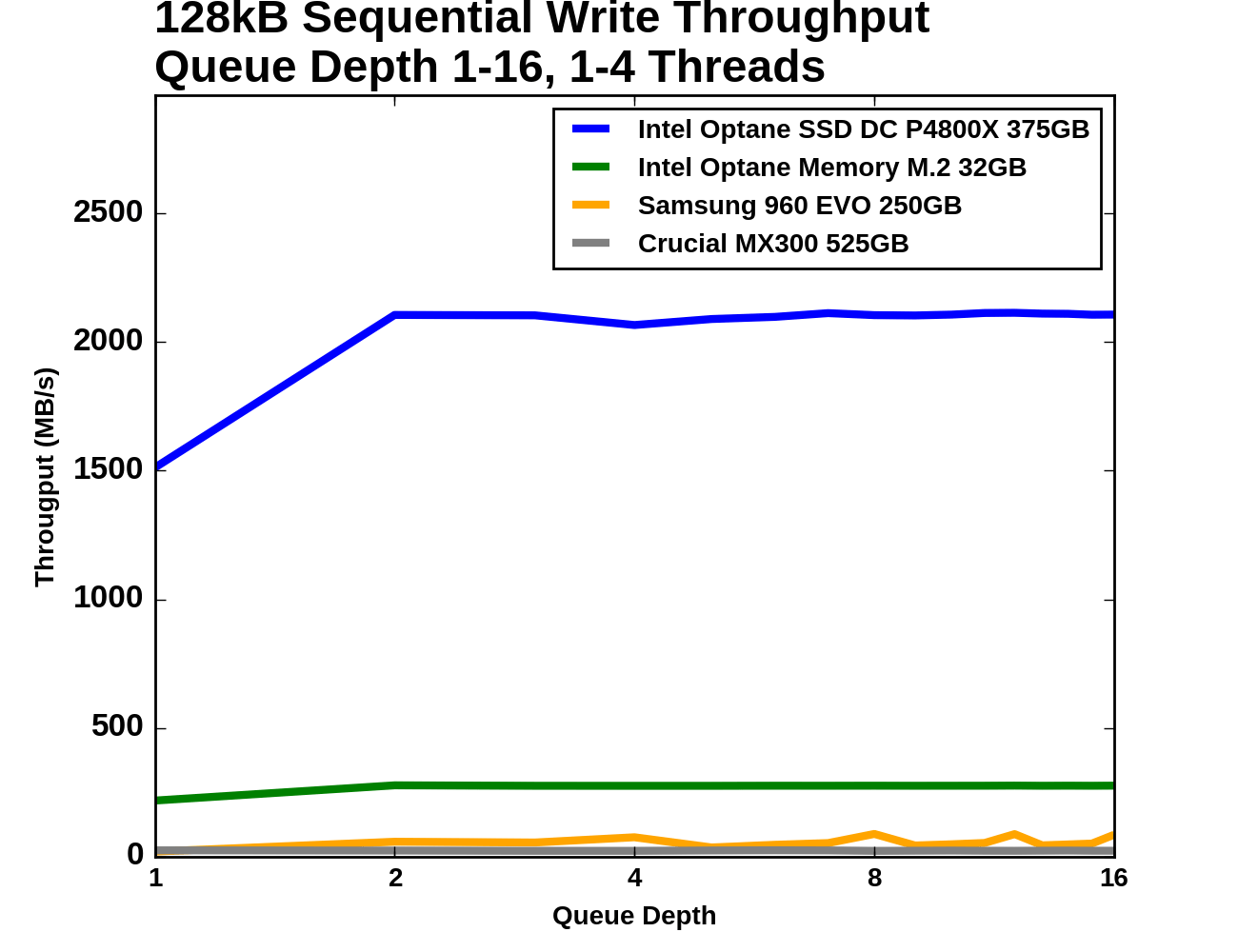 |
|||||||||
| Vertical Axis scale: | Linear | Logarithmic | |||||||
The Crucial MX300 is the only drive that does not get a throughput boost going from QD1 to QD2; as with the random write test it is not able to improve performance when the higher queue depth is due to multiple threads writing to the drive. The Samsung 960 EVO improves from the addition of a second thread but beyond that it simply gets more inconsistent. The Optane Memory and P4800X are both very consistent and saturated at QD2 after a moderate improvement from QD1.
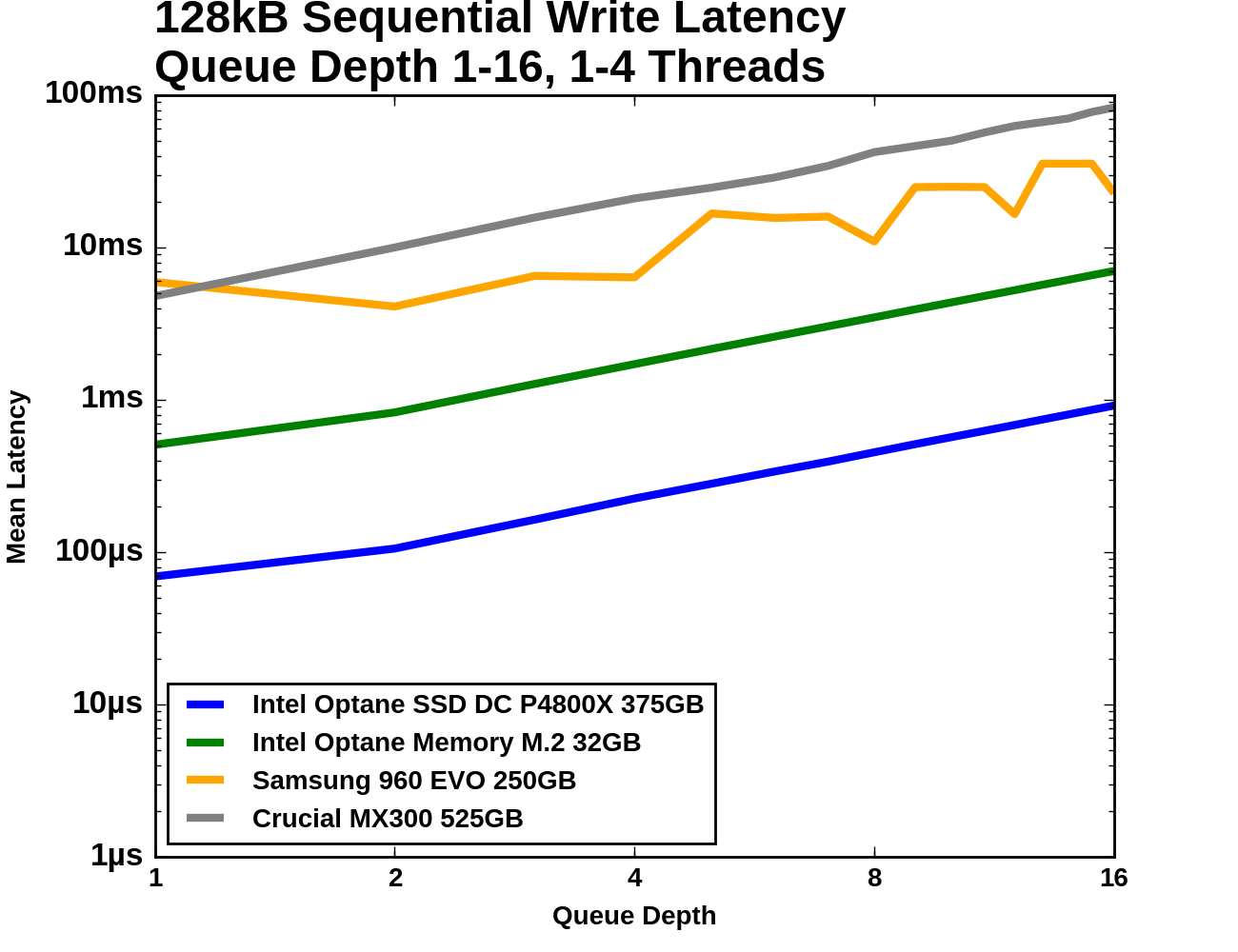 |
|||||||||
| Mean | Median | 99th Percentile | 99.999th Percentile | ||||||
The flash SSDs get more inconsistent with increased thread count and queue depth, but other than that the latency charts show the predictable growth in latency that comes from the drives all being saturated in terms of throughput.












110 Comments
View All Comments
name99 - Tuesday, April 25, 2017 - link
Why are you so sure you understand the technology? Intel has told us nothing about how it works.What we have are
- a bunch of promises from Intel that are DRAMATICALLY not met
- an exceptionally lousy (expensive, low capacity) product being sold.
You can interpret these in many ways, but the interpretation that "Intel over promised and dramatically underdelivered" is certainly every bit as legit as the interpretation "just wait, the next version (which ships when?) will be super-awesome".
If Optane is capable TODAY of density comparable to NAND, then why ship such a lousy capacity? And if it's not capable, then what makes you so sure that it can reach NAND density? Getting 3D-NAND to work was not a cheap exercise. Does Intel have the stomach (and the project management skills) to last till that point, especially given that the PoS that they're shipping today ain't gonna generate enough of a revenue stream to pay for the electric bill of the Optane team while they take however long they need to get out the next generation.
emn13 - Tuesday, April 25, 2017 - link
Intel hasn't confirmed what it is, but AFAICT all the signs point to xpoint being phase-change ram, or at least very similar to it. Which still leaves a lot of wiggle room, of course.ddriver - Tuesday, April 25, 2017 - link
IIRC they have explicitly denied xpoint being PCM. But then again, who would ever trust a corporate entity, and why?Cellar - Tuesday, April 25, 2017 - link
Implying Intel would only use only the revenue of Optane to fund their next generation of Optane. You forget how much profit they make milking out their Processors? *Insert Woody Harrelson wiping tears away with money gif*name99 - Tuesday, April 25, 2017 - link
Be careful. What he's criticizing is the HYPE (ie Intel's business plan for this technology) rather than the technology itself, and in that respect he is basically correct. It's hard to see what more Intel could have done to give this technology a bad name.- We start with the ridiculous expectations that were made for it. Most importantly the impression given that the RAM-REPLACEMENT version (which is what actually changes things, not a faster SSD) was just around the corner.
- Then we get this attempt to sell to the consumer market a product that makes ZERO sense for consumers along any dimension. The product may have a place in enterprise (where there's often value in exceptionally fast, albeit expensive, particular types of storage), but for consumers there's nothing of value here. Seriously, ignore the numbers, think EXPERIENCE. In what way is the Optane+hard drive experience better than the larger SSD+hard drive or even large SSD and no hard drive experience at the same price points. What, in the CONSUMER experience, takes advantage of the particular strengths of Optane?
- Then we get this idiotic power management nonsense, which reduces the value even further for a certain (now larger than desktop) segment of mobile computing
- And the enforced tying of the whole thing to particular Intel chipsets just shrinks the potential market even further. For example --- you know who's always investigating potential storage solutions and how they could be faster? Apple. It is conceivable (obviously in the absence of data none of us knows, and Intel won't provide the data) that a fusion drive consisting of, say, 4GB of Optane fused to an iPhone or iPad's 64 or 128 or 256GB could have advantages in terms of either performance or power. (I'm thinking particularly for power in terms of allowing small writes to coalesce in the Optane.)
But Intel seems utterly uninterested in investigating any sort of market outside the tiny tiny market it has defined.
Maybe Optane has the POTENTIAL to be great tech in three years. (Who knows since, as I said, right know what it ACTUALLY is is a secret, along with all its real full spectrum of characteristics).
But as a product launch, this is a disaster. Worse than all those previous Intel disasters whose names you've forgotten like ViiV or Intel Play or the Intel Personal Audio Player 3000 or the Intel Dot.Station.
Reflex - Tuesday, April 25, 2017 - link
Meanwhile in the server space we are pretty happy with what we've seen so far. I get that its not the holy grail you expected, but honestly I didn't read Intel's early info as an expectation that gen1 would be all things to all people and revolutionize the industry. What I saw, and what was delivered, was a path forward past the world of NAND and many of its limitations, with the potential to do more down the road.Today, in low volume and limited form factors it likely will sell all that Intel can produce. My guess is that it will continue to move into the broader space as it improves incrementally generation over generation, like most new memory products have done. Honestly the greatest accomplishment here is Intel and Micron finally introducing a new memory type, at production quantity, with a reasonable cost for its initial markets. We've spent years hearing about phase-change, racetrack, memrister, MRAM and on and on, and nobody has managed to introduce anything at volume since NAND. This is a major milestone, and hopefully it touches off a race between Optane and other technologies that have been in the permanent 3-5 year bucket for a decade plus.
ddriver - Tuesday, April 25, 2017 - link
Yeah, I bet you are offering hypetane boards by the dozens LOL. But shouldn't it be more like "in the _servers that don't serve anyone_ space" since in order to take advantage of them low queue depth transfers and latencies, such a s "server" would have to serve what, like a client or two?I don't claim to be a "server specialist" like you apparently do, but I'd say if a server doesn't have a good saturation, they either your business sucks and you don't have any clients or you have more servers than you need and should cut back until you get a good saturation.
To what kind of servers is it that beneficial to shave off a few microseconds of data access? And again, only in low queue depth loads? I'd understand if hypetane stayed equally responsive regardless of the load, but as the load increases we see it dwindling down to the performance of available nand SSDs. Which means you won't be saving on say query time when the system is actually busy, and when the system is not it will be snappy enough as it is, without magical hypetane storage. After all, servers serve networks, and even local networks are slow enough to completely mask out them "tremendous" SSD latencies. And if we are talking an "internet" server, then the network latency is much, much worse than that.
You also evidently don't understand how the industry works. It is never about "the best thing that can be done", it is always about "the most profitable thing that can be done". As I've repeated many times, even NAND flash can be made tremendously faster, in terms of both latency and bandwidth, it is perfectly possible today and it has been technologically possible for years. Much like it has been possible to make cars that go 200 MPH, yet we only see a tiny fraction of the cars that are actually capable to make that speed. There has been a small but steady market for mram, but that's a niche product, it will never be mainstream because of technological limitations. It is pretty much the same thing with hypetane, regardless of how much intel are trying to shove it to consumers in useless product forms, it only makes sense in an extremely narrow niche. And it doesn't owe its performance to its "new memory type" but to its improved controller, and even then, its performance doesn't come anywhere close to what good old SLC is capable of technologically as a storage medium, which one should not confuse with a compete product stack.
The x25-e was launched almost 10 years ago. And its controller was very much "with the times" which is the reason the drive does a rather meager 250/170 mb/s. Yet even back then its latency was around 80 microseconds, with its "latest and greatest" hypetane struggling to beat that by a single order of magnitude 10 years later. Yet technologically the SLC PE cycle can go as low as 200 nanoseconds, which is 50 times better than hypetane and 400 times better than what the last pure SLC SSD controller was capable of.
No wonder the industry abandoned SLC - it was and still is too good not only for consumers but also for the enterprise. Which begs the question, with the SLC trump card being available for over a decade why would intel and micron waste money on researching a new media. And whether they really did that, or simply took good old SLC, smeared a bunch of lies, hype and cheap PR on it to step forward and say "here, we did something new".
I mean come on, when was the last time intel made something new? Oh that's right, back when they made netburst, and it ended up a huge flop. And then, where did the rescue come from? Something radically new? Nope, they got back to the same old tried and true, and improved instead of trying to innovate. Which is also what this current situation looks like.
I can honestly think of no better reason to be so secretive about the "amazing new xpoint", unless it actually isn't neither amazing, nor new, nor xpoint. I mean if it s a "tech secret" I don't see how they shouldn't be able to protect their IP via patents, I mean if it really is something new, it is not like they are short on the money it will take to patent it. So there is no good reason to keep it such a secret other than the intent to cultivate mystery over something that is not mysterious at all.
eddman - Tuesday, April 25, 2017 - link
This is what happens when people let their personal feelings get in the way."Even if they cure cancer, they still suck and I hate them"
ddriver - Tuesday, April 25, 2017 - link
Except it doesn't cure cancer. And I'd say it is always better to prevent cancer than to have the destructive treatment leave you a diminished being.eddman - Tuesday, April 25, 2017 - link
Just admit you have a personal hatred towards MS, intel and nvidia, no matter what they do, and be done with it. It's beyond obvious.